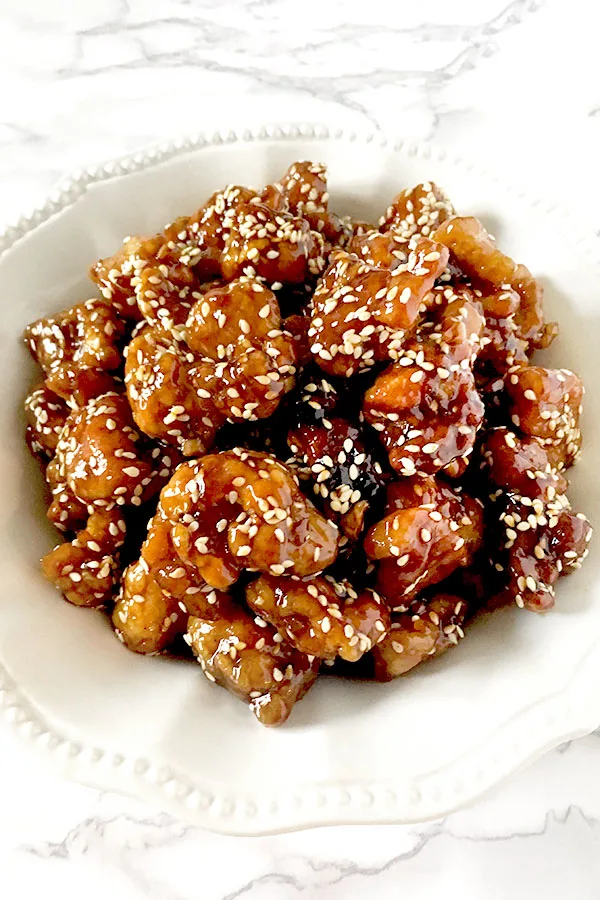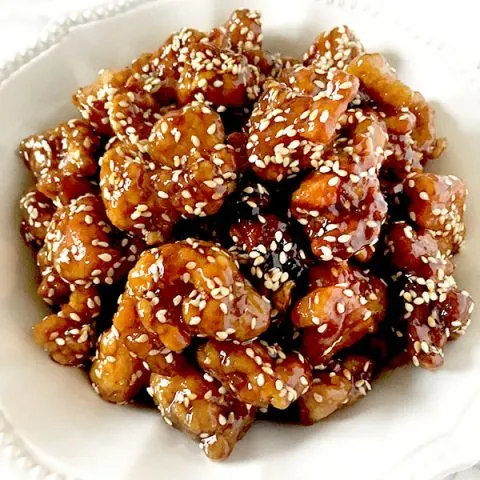This kosher recipe for sesame chicken gives you a crunchy chicken coated in its classic sweet sauce.
It is easy to make at home and tastes just like sesame chicken in Chinese restaurants.
Serve with rice and steamed broccoli.

If there is one thing my family misses since moving to Israel, it’s Chinese food.
Sure, there are Asian restaurants in Israel, but they do it differently.
Even if they had authentic Chinese food, it wouldn’t be the same because what we miss is American-Chinese food.
What they long for are dishes that are completely unfamiliar to a native Chinese pallet.
I’m talking about sesame chicken, orange chicken, General Tso's chicken, and let’s not forget my favorite, beef and broccoli.
This inspired me to see if I can make these recipes and more on my own.
I started with lemon chicken, a dish popular in Canadian Chinese takeout, because I had a bunch of lemon sitting around.
Once I saw how easy it was to make that, I figured it would be just as easy to make most things and I wasn’t wrong.
This recipe couldn’t be easier.
At first glance, it looks like a laundry list of ingredients, but really most of them repeat and you can easily find all of them in your pantry or kitchen cupboards.
Why does this recipe suggest dry sherry?
Some sesame chicken recipes call for shaoxing wine.
Shaoxing wine is not only hard to find depending on where you are from (and I don’t like requiring specialty items in my recipes), but is also exceedingly hard - if possible at all - to find kosher.
So, since dry sherry is easier to find and can be found kosher, I list it as an option.
However, I personally don’t think this ingredient changes the recipe enough to make it a requirement.
You can easily make this recipe without dry sherry. I usually leave it out.
Why is sesame oil optional?
Sesame oil is relatively expensive and adds more calories to an already fattening dish. Most recipes require it and if you have it on hand, you are welcome to use it.
Personally though, I don’t think it makes enough of a difference to the flavor to require it, and when making this dish, I usually leave it out.
DARK MEAT VS WHITE MEAT
Most people have a preference between eating white meat or dark meat. They both certainly have their benefits and detriments in this recipe.
White meat has the benefit of being lean, more readily available as boneless and skinless, and it cooks quickly.
Dark meat is juicier and does not dry out as quickly, making it a safer choice.
At the end of the day, you can use either white or dark meat for this recipe. The choice is yours. I often just choose based on what I have on hand.
GLUTEN FREE OPTION
For a gluten free alternative, use corn starch or potato starch instead of flour. They both fry very nicely.
HOW TO DREDGE CHICKEN
Double Handed
Use one hand to dip the chicken in the egg and the other to roll it in flour. By using both hands, you avoid getting thick layers of batter on your fingers known as “club hand.”
Container Technique
Place half the flour at the bottom of a container. Add the chicken and cover with the remaining flour. Cover with a lid and shake for a few minutes. Each piece should come out well coated.
A WORD ON OIL
When frying chicken, the temperature of the oil is important.
If it’s too cold, the chicken will be oily. On the other hand, if the oil is too hot, the crust will fall off. With a thermometer, it should about 350°F or 175°C to 375°F or 190°C degrees.
If you don’t have a thermometer, when the oil seems hot, drop a little flour into the oil. If the flour sizzles and floats on the top, it’s hot enough.
To make sure it’s not too hot, keep it around medium-low and adjust as needed.
IS KOSHER CHICKEN BETTER?
Kosher animals are kept in better conditions than non-kosher animals due to strict kosher health requirements of the animals.
Also, the salting process used as part of the process of making meat kosher is similar to dry brining, and therefore produces a better quality meat.
While I’ve only eaten kosher meat so I cannot compare, I’ve been told by non-Jews who do not keep kosher that they’ve noticed that kosher chicken is of superior quality to cook with.
SHOULD YOU WASH CHICKEN?
According to the USDA, you should not wash meat or poultry, since water can splash bacteria up to 3 feet surrounding your sink.
A study done by Drexel University shows that it is best to move meat and poultry directly from package to pan. The heat from cooking will get rid of any bacteria that may be present.
HOW CAN I CLEAN MY CHICKEN WITHOUT WASHING IT?
If you want to clean your chicken without washing it, wipe it down with a wet paper towel.
Just make sure the paper towel doesn't touch anything else and to toss the paper towel right away.
HOW TO DEFROST CHICKEN
IN THE FRIDGE
Defrosting chicken in the fridge is the most highly recommended.
To do this, place the frozen chicken in a pan and let it thaw. Oftentimes, when chicken thaws, it releases liquids that can leak onto your fridge, so the pan is really helpful.
Chicken typically takes a full day to thaw. Once thawed, it can remain in the refrigerator for a day or two before cooking.
IN COLD WATER
Defrosting chicken in water should take two to three hours.
Submerge your sealed chicken in a pot or bowl full of cold water. Change out the water every 30 minutes or so.
Do not hot use water because it can start cooking your chicken.
Can you cook FROZEN chicken?
According to the USDA, you can cook frozen chicken. It will take 50% longer to cook, but it’s an option.
You should also cook it on a roasting rack or over vegetables so that the heat can circulate around the chicken.
CAN YOU REFREEZE RAW CHICKEN?
According to the USDA, “food thawed in the refrigerator is safe to refreeze without cooking.” However, you do lose quality when refreezing previously defrosted meat.
Every time you defrost meat, it loses moisture as it thaws, which also leads to a loss in flavor. To compensate for this, marinate the chicken to add more flavor and juice.
The USDA also says not to “refreeze any foods left outside the refrigerator longer than 2 hours; 1 hour in temperatures above 90°F.”
SHOULD YOU BRINE?
Brining actually doesn’t do anything to help poultry. In fact, it makes it soggy rather than juicy, with watered-down flavor.
Aromatic brines and stock don’t help with flavor either. This is because the salt pulls water molecules in, leaving most of the flavor behind.
DRY BRINING
A dry brine, on the other hand, loosens up muscle fibers, allowing them to retain more moisture without adding any excess liquid.
Initially, the salt draws moisture out, then it dissolves in this liquid, creating a concentrated brine, which eventually gets reabsorbed. This leads to more intensely flavored results.
An added benefit is that it also requires less space and mess than a water brine. Not to mention the fact that it allows for crispier skin.
CAN YOU DRY BRINE KOSHER chicken?
Food experts are often under the impression that kosher meat and poultry cannot be brined and dry brined.
This is because of the koshering process, which involves salting the meat. However, the process is not nearly as long as the dry brining process, and unlike a dry brine, the poultry is soaked to remove the salt.
So, since the process is different than a dry brine, it is fine and even recommended to dry brine kosher poultry and meat.
How do you dry brine chicken?
Begin by patting the chicken with paper towels. This will help the salt adhere to the chicken.
Grab pinches of kosher salt and sprinkle it over the chicken until the chicken is generously salted and evenly coated.
Place the dry-brined chicken on a rack or a plate and refrigerate it. Refrigerate chicken pieces for at least 1 hour, skinless pieces for 30 minutes to 1 hour or up to about 12 hours, and a whole chicken for 8-24 hours.
Once the waiting period is up, there is no need to rinse off the chicken. Just cook it as usual.
HOW TO STORE CHICKEN
Place cooled chicken in an airtight container or wrap in heavy-duty aluminum foil or plastic wrap. Store in the fridge for up to 4 days.
HOW TO FREEZE CHICKEN
Freeze leftovers within 3-4 days. Place cooled chicken in an airtight container or resealable freezer bag.
Freeze for up to 4-6 months. After that, it is still safe to eat, but the quality begins to degrade.
Kosher Sesame Chicken

This easy recipe for Chinese sesame chicken gives you a crunchy chicken coated in its classic sweet sauce.
Ingredients
Batter
- 1 egg
- 3 tablespoons cornstarch
- 2 tablespoons soy sauce
- 1 pound chicken, boneless and skinless (455 grams), cut into ½ to ¾-inch chunks (1.3 to 2 centimeters))
Dry Coating
- ½ cup cornstarch (65 grams)
- ½ cup all-purpose flour (65 grams)
- ½ teaspoon baking powder
- ½ teaspoon kosher salt
Sauce
- 1 teaspoon peanut or neutral flavored oil
- 2 medium cloves garlic, minced
- ½-inch piece ginger, minced
- 3 tablespoons soy sauce
- 2 tablespoons dry sherry, optional
- 2 tablespoons brown sugar
- 2 tablespoons white sugar
- 1 tablespoon cornstarch
- 1 tablespoon distilled white vinegar
- 2 teaspoons roasted sesame seed oil
- 1 teaspoon chicken bouillon powder
- 2 tablespoons toasted sesame seeds
Instructions
- Whisk to combine egg, cornstarch, and soy sauce in a mixing bowl. Once you have a smooth batter, add the chicken and let sit for half an hour.
- In a second mixing bowl, add cornstarch, flour, baking soda, and salt. Whisk to combine.
- Heat oil in preferably a heavy bottom frying pan or a wok. You know the oil is hot enough when you drop in a bit of batter and it sizzles. You want a temperature between 325°F and 375°F or 160°C and 190°C.
- Roll each piece of battered chicken in the dry mixture. Shake off excess and add it to the hot oil. Repeat until the pan is full but not overcrowded. Fry until crispy and place on a paper towel lined plate. Repeat in batches with the remaining pieces of chicken.
- In a frying pan, add oil. When it begins to simmer, add garlic and ginger. Lightly fry for about 10 seconds, constantly stirring.
- Add soy sauce, sherry if desired, brown sugar, white sugar, cornstarch, vinegar, sesame oil, and bouillon powder. Stir until everything is well combined, including the sugar. Simmer until it develops a thick syrup-like texture. Let cool slightly.
- Place the chicken in the sauce, sprinkle sesame seeds, and toss to coat.
Nutrition Information:
Yield:
4Serving Size:
1Amount Per Serving: Calories: 583Total Fat: 26gSaturated Fat: 5gTrans Fat: 0gUnsaturated Fat: 19gCholesterol: 154mgSodium: 1574mgCarbohydrates: 53gFiber: 1gSugar: 12gProtein: 32g

Roger
Tuesday 12th of October 2021
A genuinely excellent article which explains everything a home cook needs to know.
ElissaBeth
Tuesday 12th of October 2021
I'm glad you found it helpful :)
Monday 9th of September 2019
sound very good,i'll try it for sure
ElissaBeth
Monday 9th of September 2019
I look forward to hearing how you enjoy it :)